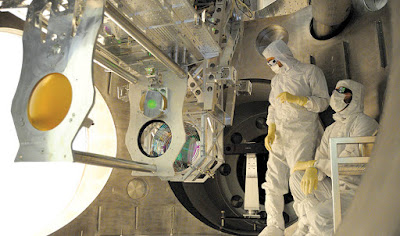 |
| Image Source: Link below |
Topics: Astrophysics, Black Holes, Cosmology, Gravitational Waves, LIGO
Decades of experimental effort paid off spectacularly on 14 September 2015, when the two detectors of the Laser Interferometer Gravitational-Wave Observatory (LIGO) spotted the gravitational waves generated by a pair of coalescing black holes.1 To get a sense of the effort leading to that breakthrough, consider that the gravitational waves caused the mirrors at the ends of each interferometer’s 4 km arms to oscillate with an amplitude of about 10−18 m, roughly a factor of a thousand smaller than the classical proton radius. The detection was also a triumph for theory. The frequency and amplitude evolution of the measured waves precisely matched general relativity’s predictions for the signal produced by a binary black hole merger, even though the system’s gravity was orders of magnitude stronger than that of any system that had been precisely probed before that detection.
Labeled GW150914, that first reported event was soon joined by other detections of binary black hole mergers. Each of those events appeared to be totally dark to traditional astronomical instruments—the matter and electromagnetic fields near the merging black holes were not sufficient to generate any signal other than gravitational. As had long been promised, gravitational waves have opened a window onto an otherwise invisible sector of the universe.
Measuring cosmic distances with standard sirens, Physics Today
Daniel Holz is a professor of physics and of astronomy and astrophysics at the University of Chicago.
Scott Hughes is a professor of physics at MIT in Cambridge, Massachusetts.
Bernard Schutz is a professor of physics and astronomy at Cardiff University in the UK.
Comments